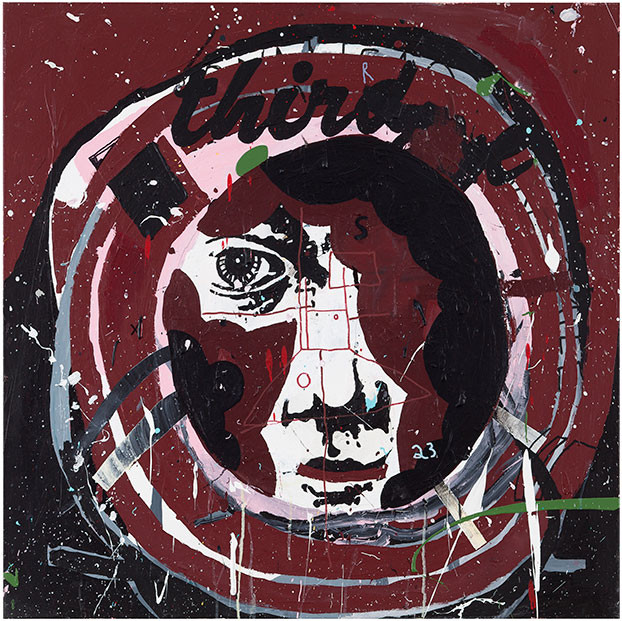Jani Hänninen
04 - 28 Oct 2012
JANI HÄNNINEN
Room 40
4 - 28 October 2012
Jani Hänninen (born 1974) was originally a wild graffiti painter, a street artist, who went on to be polished at the Finnish Academy of Fine Arts. His paintings still have the appearance of spontaneity and being created in a moment, and the viewer can imagine that they are based on deep and rapid emotions, and a technique that is no less quick.
In reality, however, Jani Hänninen plans, chooses and composes. He knows, at least roughly, what he wants to say and seeks the best possible way to express it. He paints, reflects and paints again. Just like the all the best artists that we think are spontaneous. Mutatis mutandis, in Hemingway’s words: “You have to write so many times that it looks easy.”
The artist “hijacks” his themes from various sources: newspapers, music, television and the street. Even a single word can spur chains of association that are transformed into colour and form on canvas. The greatest theme, of course, is life and the feelings aroused by it, which are often chaotic, conflicting and even oppressive.
Over the past two years, Hänninen has been “terribly interested” in letters, numbers, crosswords, Sudoku puzzles: codes. This also provides the name of the exhibition, “Room 40”, which was the office where British Naval Intelligence cracked German codes in during the First World War.
Jani Hänninen’s paintings are rich, sumptuous and strong, of vigorous composition and precise expression.
Art professionals have understood the specific nature and value of Jani Hänninen's work for a long while. His paintings have been acquired for the collections of the Sara Hildén Art Museum, the Malmö Art Museum, the Helsinki Art Museum, the Wihuri Foundation/Rovaniemi Art Museum, the Kiasma Museum of Contemporary Art, the City of Tampere, and the Kuntsi Museum of Modern Art (The Lars Swanljung Collection). Jani Hänninen has also participated in several art fairs in association with Galerie Anhava, and in exhibitions at the Sara Hildén Art Museum, the Oulu Art Museum, the Kiasma Museum of Contemporary Art, the Kuntsi Museum of Modern Art, and the Helsinki Art Museum.
Room 40
4 - 28 October 2012
Jani Hänninen (born 1974) was originally a wild graffiti painter, a street artist, who went on to be polished at the Finnish Academy of Fine Arts. His paintings still have the appearance of spontaneity and being created in a moment, and the viewer can imagine that they are based on deep and rapid emotions, and a technique that is no less quick.
In reality, however, Jani Hänninen plans, chooses and composes. He knows, at least roughly, what he wants to say and seeks the best possible way to express it. He paints, reflects and paints again. Just like the all the best artists that we think are spontaneous. Mutatis mutandis, in Hemingway’s words: “You have to write so many times that it looks easy.”
The artist “hijacks” his themes from various sources: newspapers, music, television and the street. Even a single word can spur chains of association that are transformed into colour and form on canvas. The greatest theme, of course, is life and the feelings aroused by it, which are often chaotic, conflicting and even oppressive.
Over the past two years, Hänninen has been “terribly interested” in letters, numbers, crosswords, Sudoku puzzles: codes. This also provides the name of the exhibition, “Room 40”, which was the office where British Naval Intelligence cracked German codes in during the First World War.
Jani Hänninen’s paintings are rich, sumptuous and strong, of vigorous composition and precise expression.
Art professionals have understood the specific nature and value of Jani Hänninen's work for a long while. His paintings have been acquired for the collections of the Sara Hildén Art Museum, the Malmö Art Museum, the Helsinki Art Museum, the Wihuri Foundation/Rovaniemi Art Museum, the Kiasma Museum of Contemporary Art, the City of Tampere, and the Kuntsi Museum of Modern Art (The Lars Swanljung Collection). Jani Hänninen has also participated in several art fairs in association with Galerie Anhava, and in exhibitions at the Sara Hildén Art Museum, the Oulu Art Museum, the Kiasma Museum of Contemporary Art, the Kuntsi Museum of Modern Art, and the Helsinki Art Museum.

